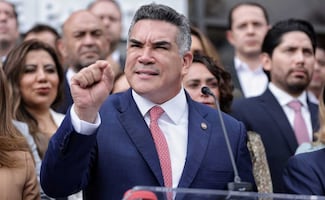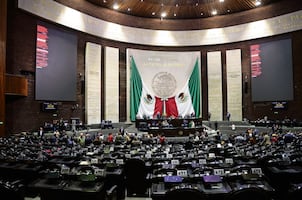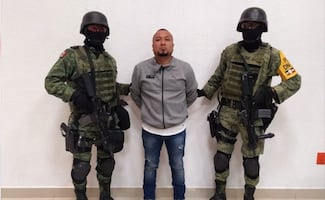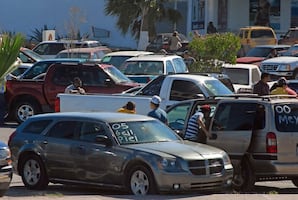Más Información

Alito Moreno afirma que México debe ser aliado de EU ante dictaduras como la de Maduro; "¡Venezuela libre ya!”

Morena va contra “Ley Esposa” en SLP que postula solo mujeres en 2027, señala Alcalde; prepara acción de inconstitucionalidad
When Andrés Manuel López Obrador took office on December 2018, he vowed not to repeat the “failed policies ” implemented by previous administrations, which did very little to decrease crime .
But last week, several events in Sinaloa , Michoacán , and Guerrero , including two mass killings and an all-out gun battle on October 17, saw security forces overwhelmed by c artel gunmen and raised questions about the effectiveness of López Obrador's security strategy .
What happened in Mexico last week?
On October 14, cartel gunmen killed 13 police in an ambush in Aguililla , in Michoacán , which has been convulsed by drug cartels, especially the Jalisco New Generation Cartel ( CJNG ) and its enemies.
Then, on October 15, a shooting left 14 armed civilians and one soldier dead in Tepochica , a community near Iguala , a city known for disappearances of 43 students in 2014. This mass killing raised questions about whether the army used excessive force .
On October 17 , Mexican authorities arrested Ovidio Guzmá n, the son of Joaquín “El Chapo” Guzmán . The detention turned the streets of Culiacán , Sinaloa into a war zone. Cartel gunmen surrounded security forces and forced them free Ovidio Guzmán.
, and the Aguililla massacre here .
What is Mexico's security strategy?
President López Obrador’
s new strategy to eradicate crime focuses on addressing and eliminating the causes behind violence , such as poverty and corruption , as well as creating more job opportunities .
So far, López Obrador has raised wages along the Mexico-U.S. border, created thousands of apprenticeships, and is promoting investment in the south.
The Mexican President also created the new National Guard force to replace the federal police.
Is the new security strategy working?
No. This year, homicides will surpass last year’s record.
Experts
say the government has not explained how it will use the National Guard to fight the cartels . With no clear short term strategy, there is a sense that this government is less tough on cartels, said Falko Ernst, an analyst for the International Crisis Group.
“The inertia and lack of definition of a security strategy by the government has allowed regional armed conflicts to spin out of control,” Ernst said. “Criminal group members and commanders have told me in Michoacán and in Guerrero that this (inertia) has meant a looser leash.”
Read more about Mexico's bloodiest cartels.
When did Mexico's war on cartels begin?
In 2006 , Mexico’s “War on Drugs” was launched by former President Felipe Calderón, who deployed armed forces to fight drug cartels , which went from smuggling cocaine for Colombian cartels to carrying out trafficking operations by themselves. Since then, over 200,000 people have been killed in cartel-related incidents and over 40,000 people have gone missing.
The strategy fractured some cartels and resulted in a few victories for the government, including the arrest of Joaquín ”El Chapo” Guzmán . Who was extradited to the United States, where he was found guilty of drug trafficking and sentenced to life in prison .
Why is violence worsening after “El Chapo” was jailed?
The extradition of Guzmán was a double-edged sword.
An August report written by the U.S. Congressional Research Service suggests the arrest and conviction “appears to have led to violent competition from a competing cartel , the CJNG .” The CJNG split from the Sinaloa cartel in 2010 and is considered as the largest and most dangerous Mexican cartel .
Nevertheless, even when “ El Chapo” is in a Colorado prison , the cartel he founded has grown.
The Sinaloa cartel “has fought brutally for increased control of routes through the border states of Chihuahua and Baja California , with the goal of remaining the dominant drug trafficking organization ,” the Congressional Research Service report said.
The criminal organization ’s decentralized structure allowed it to adapt, the report added.
Within this decentralized structure, Ovidio Guzmán , the son of “El Chapo” Guzmán ’s, seems to have taken an active role. The U.S. Department of Justice unveiled an indictment against Ovidio and one of his brothers in February 2019, charging them with conspiracy to distribute cocaine , methamphetamine , and marijuana in the U.S.
Read about the arrest and release of Ovidio Guzmán.
On Thursday, Gladys McCormick, a security analyst at Syracuse University said that the apparent capitulation to the Sinaloa Cartel was “sending a loud message to other organized crime networks (...) that if they show up with enough firepower to a fight, they will win and get their way because the government does not have the wherewithal to fight back.”
gm
Noticias según tus intereses
[Publicidad]
[Publicidad]













